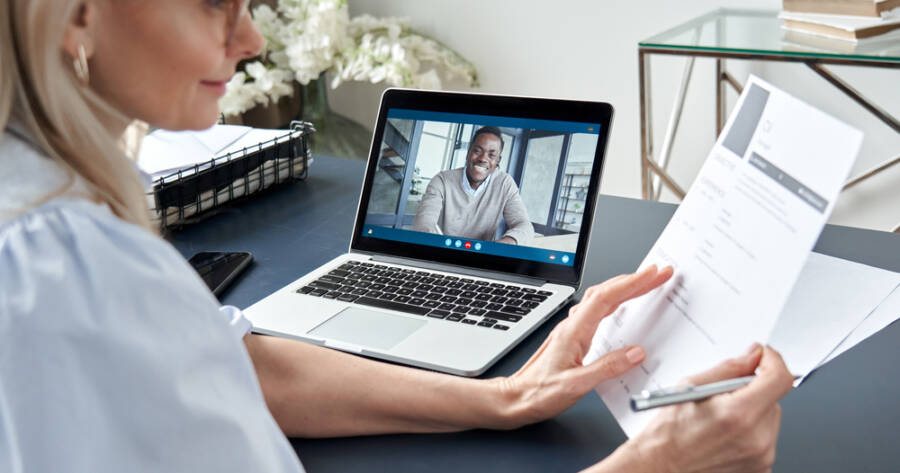Remote interviews have quickly become the standard for hiring across the United States. Instead of commuting to an office, candidates now meet hiring managers through a screen. While the format saves time and widens opportunities, it also brings unique challenges. From ensuring your technology runs smoothly to presenting yourself effectively in a digital space, mastering the art of the remote interview can make or break your chances. With preparation and awareness, you can turn virtual interviews into a strong advantage.
Preparing Your Tech Setup
The foundation of a successful remote interview is reliable technology. A stable internet connection is essential to avoid interruptions that may distract you or the interviewer. Test your microphone and camera before the interview to ensure clear sound and a sharp image. Good lighting also plays an important role. Position yourself in front of natural light if possible, or use a lamp that brightens your face without casting heavy shadows.
Many candidates underestimate the importance of the background. A cluttered or messy space can send the wrong signal. Instead, choose a neutral background, such as a plain wall or tidy home office. Virtual backgrounds may be acceptable, but they can sometimes glitch or feel less personal. By paying attention to these details, you create a setting that looks professional and distraction-free.
Techniques for Virtual Communication
Communicating effectively through a screen requires adjustments compared to in-person meetings. Eye contact is especially important. Instead of watching your own image or the interviewer’s video, try to look directly into the camera when you’re speaking. This small adjustment creates the impression of natural eye contact and helps build trust.
Tone and body language also carry more weight in remote interviews. Since a computer screen can limit subtle cues, it’s helpful to speak clearly, use a friendly but professional tone, and maintain good posture. Nodding occasionally shows engagement, while pausing briefly before answering allows you to gather your thoughts and avoid talking over the interviewer, especially if there is a slight delay in the connection.
Common Mistakes to Avoid
One of the most frequent mistakes candidates make is failing to test their technology until the last minute. Even if you’ve used the platform before, updates or changes can create unexpected problems. Always log in early to check your setup. Another common error is multitasking during the interview. Employers can often tell if you’re distracted by email notifications or looking at your phone. Giving your full attention demonstrates respect and focus.
Candidates also sometimes underestimate the importance of dress. While remote interviews may feel more casual, showing up in professional attire signals seriousness and respect for the process. Dressing the part also helps put you in the right mindset for a formal conversation. Finally, avoid giving overly rehearsed answers. Interviewers want to see authenticity, not memorized lines. Be prepared, but allow space for genuine conversation.
Tools to Support Your Preparation
Several digital tools can help you prepare more effectively. Platforms like Zoom and Microsoft Teams offer no-fee versions you can practice with by recording yourself and reviewing how you look and sound on camera. Online scheduling apps can help you block time before the interview to focus and avoid last-minute stress. Note-taking apps are also valuable for organizing key points about the company or role so you can reference them quickly without shuffling through papers.
Practice tools designed for interview preparation, such as mock interview platforms, allow you to rehearse answers to common questions. Reviewing these recordings helps you spot habits like speaking too quickly or failing to pause between thoughts. These tools not only improve confidence but also reduce the chance of being caught off guard during the real interview.
Building Confidence Through Practice
Confidence is one of the most critical elements of a successful remote interview. Practicing responses to common questions out loud can make you more comfortable, but practicing in front of a camera adds another layer of readiness. Recording yourself helps you see how your expressions, tone, and gestures come across in a virtual setting.
Additionally, conducting a practice interview with a friend or mentor provides feedback you may not notice on your own. They can point out distracting habits, such as fidgeting or overusing filler words. This extra layer of preparation ensures you enter the interview calm, focused, and ready to highlight your strengths.
Turning Remote Challenges Into Opportunities
Remote interviews may feel intimidating at first, but they also offer unique opportunities to showcase adaptability and professionalism. By preparing your technology, practicing virtual communication skills, and avoiding common mistakes, you can set yourself apart from other candidates.
The tools available today make it easier than ever to practice and refine your approach, while thoughtful preparation builds the confidence needed to succeed. With the right mindset, a remote interview doesn’t have to be a barrier—it can be the stage where you prove you’re the right fit for the job.

